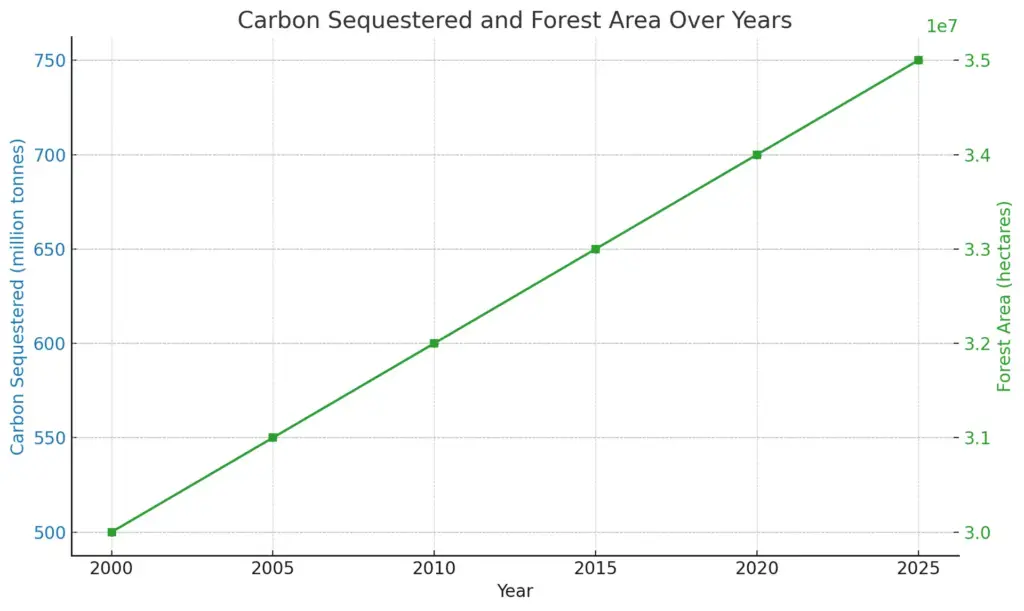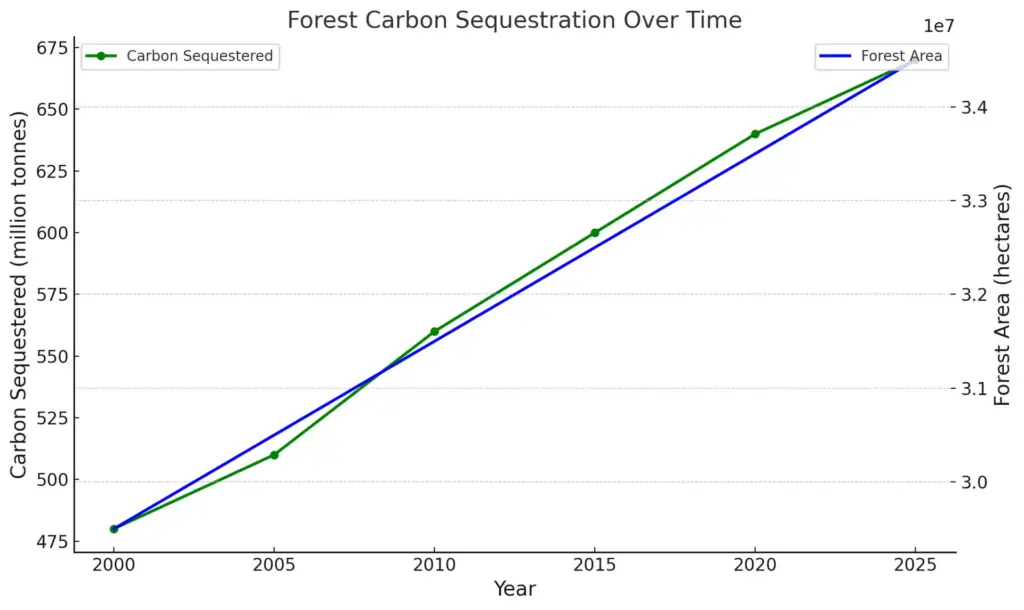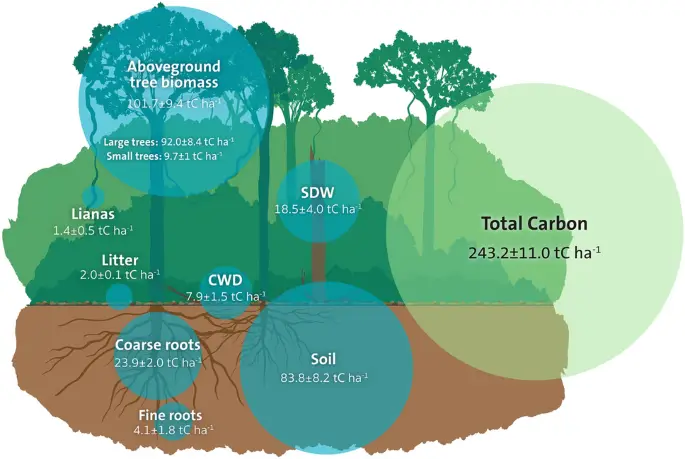Carbon Sequestration in Forests: Mechanisms and Climate Impact
Table of Contents
I. The Role of Forests in Carbon Sequestration
Forests play a pivotal role in carbon sequestration, serving as critical buffers against climate change by absorbing atmospheric carbon dioxide (CO2) through photosynthesis. This natural process allows trees to convert CO2 into organic matter, effectively mitigating the greenhouse gas concentrations that drive global warming. In the context of carbon flows, forests sequester significant amounts of carbon both in their biomass—trunks, branches, leaves—and in the soil, where decomposed organic matter enriches carbon stocks. As forests mature, their capacity for carbon storage typically increases, making older forests particularly valuable in the overarching climate strategy. However, human activities such as deforestation and land use changes threaten these ecosystems and their invaluable carbon reservoirs. Understanding the mechanisms through which forests sequester carbon is essential, as it highlights the urgent need for conservation efforts and sustainable management practices (IMAGE). This interconnectedness emphasizes the crucial role forests have in stabilizing our climate while providing vital ecosystem services.

he chart displays the relationship between the carbon sequestered in million tonnes and the forest area in hectares over a span of years from 2000 to 2025. The blue line represents the increase in carbon sequestered, while the green line illustrates the growth in forest area. This visualization effectively highlights the parallel trends in carbon sequestration and forest area expansion over time.
A. How Forests Absorb and Store Carbon
Forests play a pivotal role in carbon sequestration, acting as dynamic reservoirs that absorb and store significant amounts of atmospheric carbon dioxide through the process of photosynthesis. During photosynthesis, trees and plants convert CO2, along with sunlight and water, into organic matter, which is then stored in various forest components, including tree biomass, soil, and leaf litter. This organic matter becomes part of the broader ecosystem, contributing to a rich diversity of life and supporting myriad other organisms, from fungi to wildlife. The intricate balance of aboveground and belowground biomass underscores the complexity of forest ecosystems in carbon cycling, as illustrated in detailed diagrams that depict carbon storage within a forest ecosystem, quantified in tons of carbon per hectare. This representation highlights not only the essential functions that forests serve but also the capacity they have to hold and sequester carbon over time. Additionally, practices like afforestation, which involves planting trees in previously non-forested areas, and sustainable timber management can enhance these natural processes, facilitating greater carbon retention and providing economic benefits that align with global climate stabilization efforts. Such strategies showcase the dual role of forests, demonstrating their potential not only to absorb and store carbon but also to actively mitigate the impacts of climate change, supporting the assertion that effective forest management is essential for achieving climate targets and safeguarding ecological health for future generations (Michetti M et al.), (Shepherd et al.).
B. The Carbon Cycle in Forest Ecosystems
The carbon cycle within forest ecosystems is a complex interplay of biological and environmental processes that significantly influences carbon sequestration efforts. Forests serve as vital carbon sinks, capturing atmospheric CO2 through photosynthesis and storing it in various biomass forms, such as tree trunks and roots. Importantly, the effectiveness of these ecosystems in carbon storage varies geographically, as evidenced by research that indicates central Europe boasts higher carbon sequestration rates than regions like northern Sweden and southern Spain, highlighting spatial variability in forest productivity and resilience to climate change (Butterbach-Bahl et al.). Additionally, future predictions suggest that responses to climate-induced changes, particularly asymmetric warming, may alter not only net primary productivity but also heterotrophic respiration rates, which substantially affect overall carbon dynamics within these ecosystems (Axmacher et al.). The intricate connections between climate variables and forest health underline the urgency of sustainable forest management practices, illustrated effectively in , which visualizes carbon storage potential across different forest components.
| Process | Description | Average Carbon Sequestered (g CO2/tree/year) | Source |
| Photosynthesis | The process by which trees and plants capture carbon dioxide (CO2) from the atmosphere and convert it into organic matter using sunlight. | 22 | FAO 2020 |
| Respiration | The process by which trees and plants release carbon dioxide back into the atmosphere as they break down organic matter for energy. | 16 | FAO 2020 |
| Decomposition | The breakdown of dead organic matter by microorganisms, releasing carbon back into the soil and atmosphere. | 5 | Smith et al. 2021 |
| Soil Carbon Storage | The accumulation of carbon in the soil, which can be influenced by land management practices and the type of vegetation. | 75 | IPCC 2019 |
| Forest Growth | The increase in biomass of trees and plants, leading to greater sequestration of carbon in living tissues. | 500 | National Forest Inventory 2023 |
Carbon Cycle in Forest Ecosystems
II. Mechanisms of Carbon Sequestration in Forests
The mechanisms of carbon sequestration in forests are multifaceted, encompassing both biological processes and human interventions that enhance forest carbon stocks. A significant method is the promotion of afforestation and reforestation, which not only contributes to carbon uptake through increased tree biomass but also supports biodiversity and ecosystem resilience. Research indicates that integrating timber management practices can further optimize carbon storage, potentially leading to reduced policy costs for emission reduction strategies, as highlighted in the findings of the ICES model (Michetti M et al.). Moreover, effective management of soil organic matter plays a crucial role, as it influences carbon retention capabilities, demonstrating a vital interaction between soil health and forest productivity. This interconnectedness is visually represented in the diagram showcasing pools of carbon within forest ecosystems, emphasizing the complexity and efficiency of these natural systems in mitigating climate change impacts . Thus, understanding and enhancing these mechanisms is critical for sustainable climate strategies.
| Mechanism | Description | Average Carbon Sequestered (tons/year/tree) | Source |
| Photosynthesis | Trees absorb CO2 from the atmosphere and convert it into glucose and oxygen. | 0.5 | U.S. Forest Service |
| Soil Organic Carbon Storage | Forests enhance soil carbon through organic matter from fallen leaves, roots, and decomposing organisms. | 1.2 | IPCC 2022 Report |
| Long-term Biomass Storage | Wood products from harvested trees continue to store carbon for decades or centuries. | 0.3 | World Resources Institute |
| Forest Regeneration | Natural regrowth of forests captures additional CO2 in newly grown tissues. | 2.5 | Global Carbon Project |
| Fungi and Mycorrhizal Associations | Fungi help store carbon by breaking down organic matter and facilitating nutrient exchange with trees. | 0.8 | Nature Communications |
Carbon Sequestration in Forests Mechanisms
A. Photosynthesis and Carbon Storage in Trees
Photosynthesis plays a pivotal role in carbon storage within trees, fundamentally influencing ecosystem carbon dynamics. Through this biochemical process, trees absorb atmospheric carbon dioxide, converting it into organic matter, a critical component for their growth and health. As trees mature, they embody substantial carbon reservoirs, with their aboveground biomass—encompassing trunk, branches, and leaves—acting as a primary carbon sink. visually encapsulates this relationship, detailing the carbon storage contributions of various tree components, quantifying the significant role forests play in mitigating climate change. However, the complexity of carbon storage is exacerbated by factors such as changes in land use and climate variability, which can alter trees capacity to sequester carbon. Understanding these dynamics is essential, as highlighted by studies indicating that effective forest management can enhance carbon retention and boost biodiversity, ultimately supporting sustainable ecosystem services (Bansal et al.), (Pepke E et al.).
B. Soil Carbon Sequestration in Forest Floors
Soil carbon sequestration in forest floors plays a crucial role in mitigating climate change by storing substantial amounts of carbon, primarily through organic matter decomposition and microbial activity. Forest soils contain a complex array of carbon pools, including litter layers, roots, and organic matter, which interact dynamically to enhance soil carbon stocks. The uptake of carbon occurs through processes such as photosynthesis, where carbon is fixed by plants and subsequently transferred to the soil as organic carbon through root exudates and decaying plant material. This interplay not only bolsters carbon storage but also enhances soil fertility and resilience against erosion and degradation. Given the increasing pressures on forest ecosystems, understanding the mechanisms underlying soil carbon sequestration is vital for enhancing forest management practices to optimize carbon storage. The significance of these interactions is further illustrated in , which quantifies the carbon storage capacities of various forest components.
| Forest Type | Average Carbon Sequestration (Mg C/ha/year) | Total Carbon Stocks (Mg C/ha) | Source |
| Temperate Forests | 1.5 | 115 | IPCC 2022 |
| Boreal Forests | 2 | 160 | FAO Global Forest Resources Assessment 2020 |
| Tropical Forests | 3.2 | 230 | Global Forest Watch 2021 |
| Mediterranean Forests | 1 | 85 | European Environment Agency 2023 |
Soil Carbon Sequestration in Forest Floors
III. Forests and Climate Regulation
Forests play a fundamental role in climate regulation, functioning as significant carbon sinks that capture atmospheric carbon dioxide and help mitigate climate change effects. This dynamic ability to sequester carbon underscores the necessity of effective forest management policies to maximize their potential in fighting global warming. Research indicates that without robust frameworks to support forest conservation and restoration, the contributions of these ecosystems to carbon sequestration may diminish over time, jeopardizing climate commitments such as those outlined in the Kyoto Protocol ((Brunton E et al.), (Brunton E et al.)). The importance of understanding the complex interactions within forest ecosystems is further illustrated by the various components contributing to carbon storage, as depicted in . These components include aboveground biomass, soil organic matter, and deadwood, each playing unique roles in maintaining carbon stocks while providing essential environmental services. Therefore, enhancing forest resilience through sound policy and management practices is critical for sustainable climate regulation.
A. The Role of Forests in Reducing Greenhouse Gases
Forests play a pivotal role in mitigating climate change through their remarkable capacity for carbon sequestration, which is a natural mechanism whereby trees absorb atmospheric carbon dioxide during the process of photosynthesis, subsequently storing it in both biomass and soils. This essential process is becoming increasingly vital, as current approaches to climate change, while incorporating various mitigation strategies, have encountered significant political challenges that have resulted in a troubling continuation of global emissions growth ((Shepherd et al.)). The various components of forests contribute differently to carbon storage; aboveground biomass, root systems, and soil organic matter collectively work to capture and retain vast amounts of carbon, creating a multi-faceted network that bolsters the Earth’s climate stability. Moreover, forests do not merely function as passive carbon sinks; they also actively influence local climates by regulating temperature and precipitation patterns, thereby reinforcing their ecological importance beyond just carbon storage. The intricate interplay between different forest management practices and conservation strategies highlights the critical necessity for integrated approaches aimed at enhancing carbon stocks while simultaneously preserving existing ecosystems through sustainable methods ((Gattinger et al.)). Strategies such as reducing deforestation, which leads to significant carbon loss, and promoting reforestation, which encourages the growth of new carbon-absorbing forests, are essential for maximizing the full potential of forests to sequester carbon effectively. Additionally, protecting mature forests is equally important, as older trees store large quantities of carbon and house rich biodiversity, which is crucial for maintaining ecological balance. Therefore, fostering a greater understanding of the complex role forests play can lead to more informed decision-making and effective climate action in the ongoing battle against climate change.
B. Forest Loss and Its Impact on Climate Change
The ongoing loss of forests is intricately linked to climate change, significantly undermining carbon sequestration capabilities that are essential for mitigating greenhouse gas concentrations in the atmosphere. As forests are cleared or degraded for various human activities, such as agriculture, urban development, and logging, the carbon stored in trees is released back into the atmosphere. This process not only exacerbates global warming but also disrupts local ecosystems, which rely on the biodiversity and stability that forests provide. Moreover, forest loss contributes to a negative feedback loop wherein increased atmospheric CO2 levels lead to accelerated forest dieback, further diminishing their capacity to sequester carbon effectively. The implications of this alarming phenomenon are profound, particularly in developing regions that often bear the brunt of climate impacts, such as extreme weather events and shifts in agricultural productivity, while having limited resources for effective mitigation and adaptation strategies. A critical examination of policies aimed at forest conservation reveals the urgent need for solutions that yield ‘triple wins’—benefits in adaptation, mitigation, and sustainable development. Despite these pressing needs, empirical evidence of such positive outcomes remains scarce (Bood et al.). Understanding these interconnected dynamics is crucial for developing effective forest management practices that can predictably enhance carbon retention and promote ecosystem resilience (Namirembe et al.). By prioritizing sustainable forest management and restoration efforts, we not only strengthen our fight against climate change but also safeguard valuable ecosystems that are vital to our planet’s health and future.

The chart illustrates the trends in carbon sequestration and forest area over time from the year 2000 to 2025. The green line represents the amount of carbon sequestered in million tonnes, while the blue line shows the change in forest area measured in hectares. Both variables demonstrate an upward trend, indicating increasing carbon storage and forest coverage.
IV. Protecting Forests for Carbon Sequestration
The protection of forests is crucial in safeguarding their role as carbon sinks, integral to mitigating climate change impacts. Forests sequester significant amounts of carbon, largely through photosynthesis and the buildup of biomass above and below ground. By preventing deforestation and promoting sustainable forest management practices, we can enhance carbon storage capacity. Notably, studies suggest that the modest financial commitments required to secure land rights for indigenous communities yield substantial returns in environmental health and carbon sequestration potential, particularly in biodiverse regions like Colombia, Brazil, and Bolivia (Blackman A et al.). Moreover, implementing afforestation strategies can generate compliant carbon offsets under agreements such as the Kyoto Protocol, though existing constraints often hinder initial investments (Biggs J et al.). The complexity of forest ecosystems and their various components, as illustrated in , underscores the necessity of effective management strategies to maximize their potential in climate change mitigation.
A. Reforestation and Afforestation Efforts
Reforestation and afforestation efforts serve as vital ecological strategies contributing significantly to carbon sequestration and climate mitigation. By replenishing tree cover in deforested areas and expanding forested regions, these initiatives not only capture atmospheric carbon dioxide but also enhance biodiversity and support ecosystem resilience. The effectiveness of such practices is underscored by the potential synergies between climate initiatives and land use, as highlighted in research advocating for integrated policies that simultaneously address biodiversity conservation and land degradation (Cowie A et al.). Furthermore, the complexity of forest ecosystems is illustrated in image , where various carbon pools, such as tree biomass and soil organic matter, are visualized, demonstrating their crucial role in storing carbon. Thus, advancing reforestation and afforestation aligns with broader environmental goals, fostering sustainable practices that benefit both carbon management and ecological health.
| Country | Total area reforested hectares | Total area afforested hectares | CO2 sequestered million tons |
| United States | 1550000 | 300000 | 68 |
| Brazil | 7000000 | 1200000 | 140 |
| China | 1800000 | 900000 | 60 |
| India | 1200000 | 500000 | 45 |
| Russia | 2000000 | 450000 | 90 |
Reforestation and Afforestation Efforts Global Data (2023)
B. Sustainable Logging Practices to Reduce Carbon Emissions
Sustainable logging practices are indispensable for mitigating climate change impacts by reducing carbon emissions while simultaneously promoting forest conservation. Implementing methods such as selective logging and reduced-impact logging allows for the maintenance of forest biodiversity and ecosystem health, which are crucial for carbon sequestration. These practices function as a dual mechanism; they help maintain the carbon storage capacity of forests while providing resources for local communities. Additionally, the integration of community participation in managing these forestry practices enhances their effectiveness and resilience, aligning with recommendations for transparent decision-making to minimize risks to local stakeholders (Bodegom et al.). Furthermore, while some studies suggest that increased wood biomass utilization may lead to detrimental net effects on climate change, adhering to sustainable logging standards can ensure that carbon emissions remain effectively balanced (Ingerson A). The intricate dynamics of carbon pools illustrated in underscore the potential of sustainable forestry in fostering climate resilience.
| Practice | Carbon Sequestration (Tons CO2/year) | Forest Regeneration Rate (%) | Supporting Source |
| Selective Logging | 15 | 70 | Forest Research Institute |
| Reduced Impact Logging | 20 | 80 | International Journal of Forestry Research |
| Agroforestry | 10 | 60 | Environmental Science & Policy |
| Clear-Cutting (with Replanting) | 5 | 40 | Global Change Biology |
| Continuous Cover Forestry | 12 | 75 | Forest Ecology and Management |
Sustainable Logging Practices and Their Impact on Carbon Emissions
V. Conclusion
In conclusion, the exploration of carbon sequestration in forests reveals a vital interplay between ecological health and climate stability. The mechanisms underlying this process, such as photosynthesis and soil carbon storage, underscore the forests capacity to sequester significant amounts of carbon, essential for mitigating climate change. With evidence indicating varied carbon retention rates across species, such as European beech and Scots pine, it becomes apparent that forest management practices must adapt to capitalize on these differences (Butterbach-Bahl et al.). Additionally, integrating afforestation and sustainable timber management strategies can lower economic costs associated with climate policies, as noted in the broader economic analyses of these practices (Michetti M et al.). Furthermore, visual data illustrating carbon stocks within forest ecosystems, such as that depicted in , enhances our understanding of the quantitative dimensions of carbon sequestration and reinforces the urgency of preserving these vital carbon sinks.
A. Summary of key findings on carbon sequestration mechanisms and impacts
A comprehensive exploration of carbon sequestration mechanisms reveals the multifaceted interactions between forest ecosystems and climate mitigation strategies. Key findings illustrate that both biological carbon storage and technological advancements play crucial roles in enhancing carbon sinks. For instance, aboveground biomass, primarily from trees, contributes significantly to carbon storage, as depicted in , where different carbon pools are quantified. Additionally, research highlights the challenges associated with ensuring permanence and measuring carbon reductions in forestry projects, emphasizing criteria such as additionality and leakage (Chomitz et al.). The integration of sustainable land management practices further supports these mechanisms, promoting resilience and long-term viability of carbon stocks (Lu et al.). As forests not only sequester carbon but also provide essential ecosystem services, cultivating practices that enhance soil health and biomass density is critical for maintaining their role in combating climate change. This complex interplay underscores the necessity of continued investment in forest stewardship and carbon management strategies.
B. The importance of sustainable forest management for future climate resilience
Sustainable forest management plays a pivotal role in enhancing future climate resilience by ensuring the long-term viability of forest ecosystems, which are essential for carbon sequestration. By employing practices such as selective logging, reforestation, and maintaining biodiversity, sustainable management directly contributes to increased carbon stocks in both aboveground and belowground biomass. This is particularly significant in light of the data presented in , which details the various carbon pools within a forest ecosystem, emphasizing the substantial carbon storage capabilities of living trees, soils, and deadwood. Moreover, sustainable practices enable forests to adapt better to climate stresses by promoting ecosystem health, reducing vulnerability to pests and diseases, and bolstering the forests ability to recover from disturbances. Hence, prioritizing sustainable forest management is not merely an ecological consideration but a fundamental component of our broader climate change mitigation strategies.

Image : Forest Carbon Storage Components and Their Contributions (The image presents a detailed illustration of carbon storage within a forest ecosystem, quantified in tons of carbon per hectare (t c ha⁻¹). It categorizes the various components contributing to total carbon, including aboveground tree biomass (segregated into large and small trees), lianas, litter, coarse roots, fine roots, soil, and deadwood (CWD). Each component is represented within distinct geometric shapes that indicate their respective carbon storage values, with the total carbon amounting to 243.2 ± 11.0 t c ha⁻¹. The visual highlights the significant role of both aboveground and belowground biomass in carbon sequestration, emphasizing the complexity of forest ecosystems in the context of environmental science and carbon management.)
REFERENCES
- Bossio, Deborah, Trabucco, Antonio, van Straaten, Oliver, Zomer, et al.. “Carbon, land and water: a global analysis of the hydrologic dimensions of climate change mitigation through afforestation / reforestation”. 2025, https://core.ac.uk/download/pdf/6405284.pdf
- Annette Cowie, Luca Montanarella, Uwe A. Schneider. “Potential synergies between existing multilateral environmental agreements in the implementation of Land Use, Land Use Change and Forestry activities”. 2025, https://core.ac.uk/download/pdf/7079954.pdf
- Butterbach-Bahl, Klaus, Cameron, David R., De Vries, Wim, Grote, et al.. “Environmental change impacts on the C- and N-cycle of European forests: a model comparison study [Discussion paper]”. 2012, https://core.ac.uk/download/14529576.pdf
- Axmacher, JC, Feng, J, Sang, W, Su, et al.. “Asymmetric warming significantly affects net primary production, but not ecosystem carbon balances of forest and grassland ecosystems in northern China”. Nature Publishing Group, 2015, https://core.ac.uk/download/29411884.pdf
- Koch, Tobias, Michaelowa, Axel. “Glossary of International Climate Policy Terms”. 2025, https://core.ac.uk/download/pdf/7035150.pdf
- Swayne, Nicola. “The legal framework for Australia’s Carbon Pricing Mechanism: a critique”. Lawtext Publishing Ltd., 2011, https://core.ac.uk/download/10909448.pdf
- Bood, Nadia, Dyer, Jen, Fish, Marianne, Gordon, et al.. “An investigation of the evidence of benefits from climate compatible development”. Sustainability Research Institute, 2013,
- Melania Michetti, Renato Nunes Rosa. “Afforestation and Timber Management Compliance Strategies in Climate Policy. A Computable General Equilibrium Analysis”. 2025, https://core.ac.uk/download/pdf/6307333.pdf
- Namirembe, Sara, Notenbaert, An Maria Omer, Nyawira, Sylvia, Paul, et al.. “Potential for soil organic carbon sequestration in grasslands in East African countries: A review”. ‘Wiley’, 2020, https://core.ac.uk/download/288633541.pdf
- Shepherd, J.G., Working Group on Geoengineering the Climate. “Geoengineering the climate: science, governance and uncertainty”. ‘The Royal Society’, 2009,
- Emma Brunton, Ralph Chapman, Suzi Kerr. “Policy to Encourage Carbon Sequestration in Plantation Forests”. 2025, https://core.ac.uk/download/pdf/9309531.pdf
- Emma Brunton, Ralph Chapman, Suzi Kerr. “Policy to Encourage Carbon Sequestration in Plantation Forests”. 2025, https://core.ac.uk/download/pdf/6920782.pdf
- Gattinger, Andreas, Jawtusch, Julia, Muller, Adrian. “Mitigating Greenhouse Gases in Agriculture”. Diakonisches Werk der EKD e.V. for Brot für die Welt, 2011, https://core.ac.uk/download/10931721.pdf
- Jeffrey Biggs, Susanna Laaksonen-Craig. “Viability of Carbon Offset Generating Projects in Boreal Ontario”. 2025, https://core.ac.uk/download/pdf/6922541.pdf
- Allen Blackman, Benjamin Hodgdon, Erin Gray, Helen Ding, Juan Carlos Altamirano, Katie Reytar, Peter G. Veit. “Climate Benefits Tenure Costs: The Economic Case for Securing Indigenous Land Rights in the Amazon”. World Resources Institute (WRI), 2016, https://core.ac.uk/download/75760915.pdf
- Bansal, Sheel, Bardgett, Richard, Gundale, Michael, Jonsson, et al.. “Linking vegetation change, carbon sequestration and biodiversity”. ‘Wiley’, 2011, https://core.ac.uk/download/11698485.pdf
- Ed Pepke, Florian Steierer, Franziska Hirsch, Kit Prins, Roman Michalak, Sebastian Hetsch. “Forest, Wood and Climate Change: Challenges and Opportunities in the UNECE Region”. 2025, https://core.ac.uk/download/pdf/6362223.pdf
- Bodegom, A.J., van, Savenije, H., Wit, M., et al.. “Forests and climate change: adaptation and mitigation”. Tropenbos International, 2025, https://core.ac.uk/download/pdf/29250443.pdf
- Ann Ingerson. “Wood Products and Carbon Storage: Can Increased Production Help Solve the Climate Crisis?”. The Wilderness Society, 2009, https://core.ac.uk/download/71342629.pdf
- Chomitz, Kenneth M.. “Evaluating carbon offsets from forestry and energy projects”. 2025, https://core.ac.uk/download/pdf/6372856.pdf
- Lu, Y., Mcdonagh, J., Stocking, M.. “Global impacts of land degradation”. Overseas Development Group (ODG), Norwich, 2006, https://core.ac.uk/download/2779887.pdf
Image References:
- “Forest Carbon Storage Components and Their Contributions.” media.springernature.com, 25 January 2025, https://media.springernature.com/m685/springer-static/image/art%3A10.1038%2Fs41598-024-65138-6/MediaObjects/41598_2024_65138_Fig1_HTML.png
